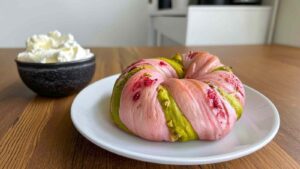This sourdough baguette recipe transforms your kitchen into a French bakery with six perfectly shaped demi-baguettes featuring golden crusts and airy interiors. I’ve spent countless mornings perfecting this two-day fermentation method that creates those signature sharp ends and tender crumb.
The smell of fresh baguettes baking always takes me back to my first attempt at bread making in Grandma’s kitchen. She’d shake her head at my lopsided loaves, but encouraged me to keep trying. Now, after years of practice, I can share what makes these sourdough baguettes truly special – That slow fermentation develops incredible flavor and may also support digestion and reduce gluten content (Verywell Health, By Lindsey DeSoto, RD, LD ), while the careful shaping creates those beautiful, dramatic points. The process takes patience, but watching your family tear into warm, crusty bread makes every minute worth it. You’re going to love this one!
Table of Contents
Why You’ll Love This Sourdough Baguette Recipe
These sourdough baguettes bring authentic French bakery magic right to your home kitchen, using time-honored techniques I’ve refined through years of bread making. The two-day fermentation process creates complex flavors that simply can’t be rushed, while the demi-baguette size fits perfectly in home ovens.
- Stunning presentation with those signature sharp, pointed ends that look professionally made
- Incredible texture contrast between the thin, golden crust and soft, airy interior
- Deep, complex flavors developed through slow fermentation and natural sourdough starter
- Perfect size for home baking – six demi-baguettes that fit standard home ovens
- Versatile serving options from breakfast toast to elegant dinner accompaniment
- Rewarding challenge that builds your bread-making confidence and skills
This sourdough baguette bread recipe isn’t just about the final product – it’s about the meditative process of working with living dough and creating something truly special with your hands.
Ingredient Note List
White Flour (11.5% protein): I always recommend using bread flour with around 11.5% protein content like Central Milling Artisan Baker’s Craft Plus because it provides the perfect balance of structure and extensibility for authentic baguette texture.
Ripe Sourdough Starter: Your starter should be bubbly, doubled in size, and pass the float test when you use it, as this active fermentation creates the signature tangy flavor and proper leavening power.
Fine Sea Salt: Fine sea salt at 1.8% of flour weight dissolves more evenly throughout the dough than coarse salt, ensuring consistent flavor without overpowering the delicate wheat taste.
Water (Temperature Controlled): I prefer using filtered water and adjusting its temperature so the final dough reaches exactly 78°F (25°C), as this optimal temperature ensures proper fermentation timing.
Levain (Pre-ferment): This 5-hour prefermented flour mixture acts as the flavor powerhouse of your sourdough baguette recipe, developing complex wheaty and malty notes that can’t be rushed.
Recipe Overview & Formula
| Recipe Details | Amount |
| Total Yield | 6 baguettes (325g each) |
| Total Dough Weight | 2000g |
| Hydration Level | 70% |
| Fermentation Time | 24 hours |
| Target Dough Temp | 78°F (25°C) |
| Complete Ingredients | Weight | Baker’s % |
| White flour (11.5% protein) | 1143g | 100% |
| Water (combined) | 800g | 70% |
| Fine sea salt | 21g | 1.8% |
| Ripe sourdough starter | 37g | 3.2% |
Two-Day Baking Schedule & Ingredients
Day 1: Build & Ferment
Sourdough
Baguettes
Day 2: Shape & Bake
| Time | Step & Details |
| 9:00 AM Divide & Preshape | Split into 6 pieces, shape into rounds Rest 35 minutes uncovered |
| 9:50 AM Final Shaping | Form 14-inch baguettes on floured couche Work confidently but gently |
| 10:15 AM-12:00 PM Final Proof | Poke test until ready 1 hour 45 minutes at room temp |
| 12:00 PM Bake | Score and bake in two batches 450°F: 20 min with steam, 20-25 min without |
How to Cook Sourdough Baguette Recipe
Day 1: Foundation Building
Morning Levain (9:00 AM): I always start by creating my levain when my starter is perfectly bubbly and active. Mix 74g white flour, 74g water, and 37g ripe starter in a small jar, then keep it cozy at 75°F for exactly 5 hours.
Afternoon Autolyse (1:00 PM): My grandmother taught me to feel the dough with wet hands – combine 1068g flour with 668g water until no dry bits remain. The mixture will look shaggy and rough, which is exactly what we want for this stage.
Evening Mix (2:00 PM): This is where the magic begins! Add 21g salt and 186g of your ripe levain to the autolyse, using 57g additional water to help everything come together. I knead for about 5 minutes using the slap and fold technique until the dough transforms from shaggy to smooth and elastic.
Warm Bulk Fermentation (2:15 PM – 4:45 PM): I’ve found that 3 sets of gentle stretch and folds, spaced 30 minutes apart, builds the perfect gluten structure. Start the first set 30 minutes after mixing, then let the dough rest completely after the third set.
Cold Overnight Rest (4:45 PM – 9:00 AM next day): Into the refrigerator the dough goes! This slow, cold fermentation develops those complex flavors that make sourdough baguettes so special while keeping the dough manageable for shaping.
Day 2: Shaping & Baking
Morning Division (9:00 AM) The cold dough feels firm and slightly damp – perfect for working with. I gently divide it into 6 equal pieces of 325g each, preshape into loose rounds, and let them relax uncovered for 35 minutes.
Baguette Shaping (9:50 AM) Here’s where practice makes perfect! I prepare my floured couche and shape each piece into a 14-inch baguette, placing them seam-side up with pleated couche walls between each one to maintain their shape.
Final Proof (10:15 AM – 12:00 PM) I keep the shaped baguettes away from drafts and test for readiness with the poke test – when gently pressed, the dough should spring back slowly but leave a slight indentation after about 1 hour 45 minutes.
Baking Time (12:00 PM) My oven preheats to 450°F with the baking stone inside for a full hour. Working in batches of 3, I score each baguette with 3 overlapping diagonal slashes, create steam, and bake for 20 minutes with steam, then 20-25 minutes without until they’re gorgeously golden brown.
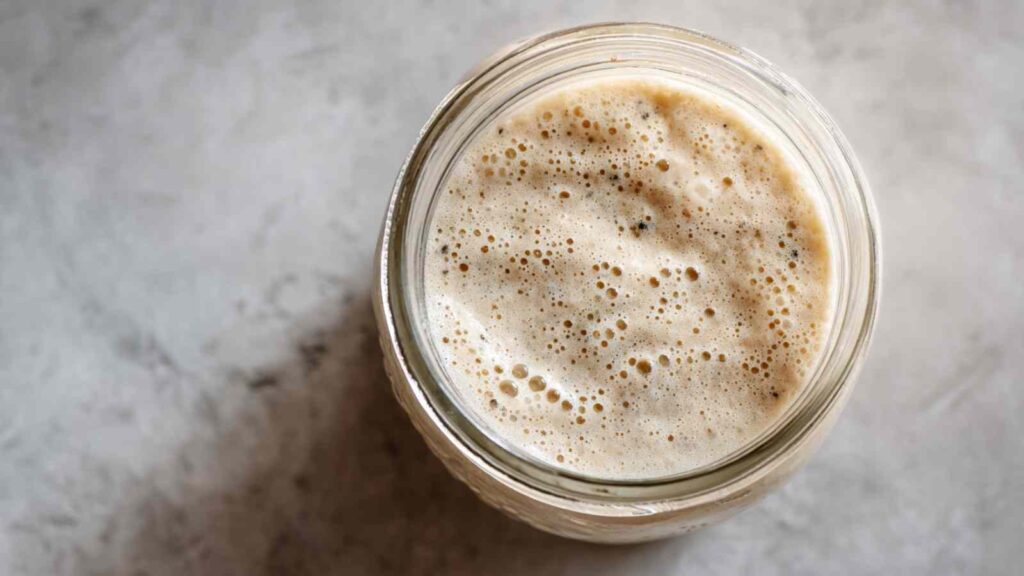
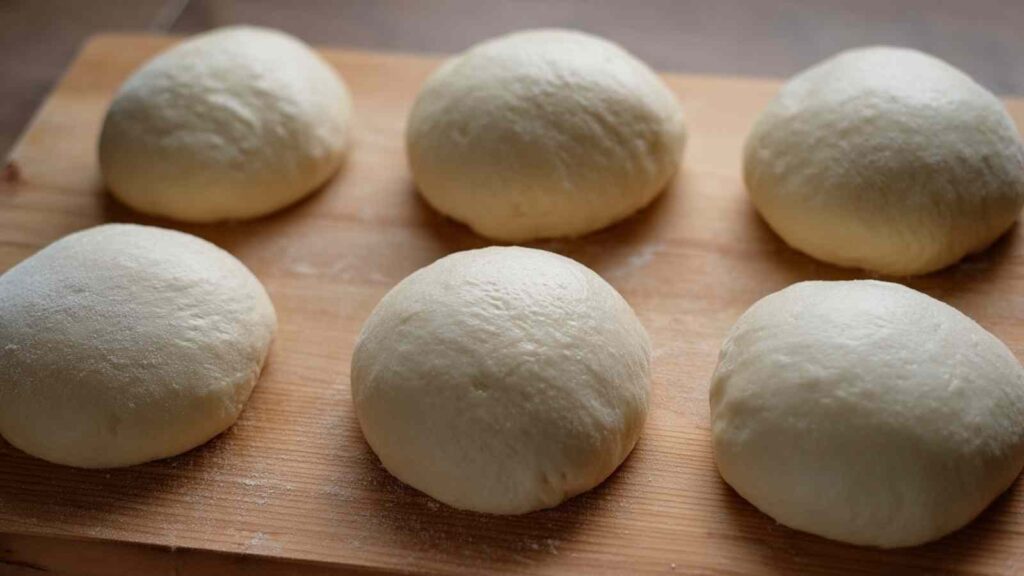
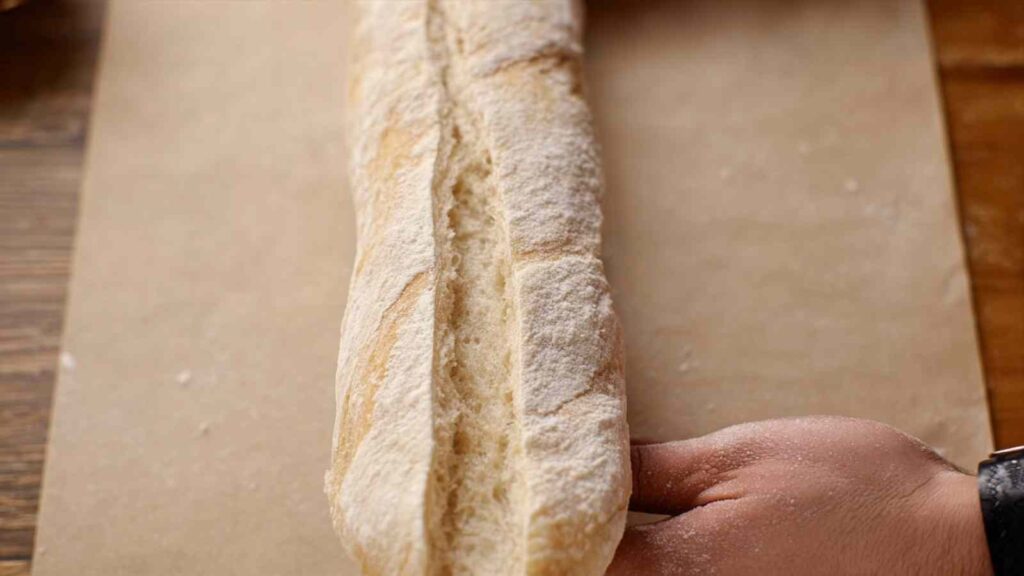
How to Store & Reheat
I usually store leftover baguettes in a paper bag at room temperature for up to 2 days, as plastic bags will soften the crust you worked so hard to create. The bread stays freshest when kept in a cool, dry place away from direct sunlight.
Freezing works wonderfully for these sourdough baguettes – I slice them first, then wrap tightly in foil and store in freezer bags for up to 3 months. This way, you can grab just the slices you need without thawing the entire loaf.
For best results, I recommend refreshing day-old baguettes by sprinkling them lightly with water and heating in a 350°F oven for 5-7 minutes. This restores that crispy crust beautifully. Individual slices can be toasted directly from frozen for quick breakfasts or snacks.
What to Serve with Sourdough Baguettes
French Onion Soup: The crusty bread is perfect for floating on top of this classic soup, where it soaks up the rich broth while maintaining some texture.
Cheese and Charcuterie Board: Sliced baguettes provide the ideal vehicle for soft cheeses, pâtés, and cured meats – the neutral flavor complements without competing. I also love including a few jalapeño cheddar bagels for guests who like a spicy twist.
Pan con Tomate: I love serving these baguettes Spanish-style, rubbed with garlic and fresh tomato, then drizzled with good olive oil and sprinkled with sea salt. This also works well with slices of whole wheat bagels if you’re after a heartier texture.
Simple Butter and Jam: Sometimes the best accompaniment is the simplest – creamy butter and your favorite jam let the bread’s complex sourdough flavors shine through. If you’re in the mood for something creative, try pairing it with Japanese pink salt blueberry bagels on the same breakfast board..
Roasted Vegetable Soup: The substantial texture of these baguettes makes them perfect for dunking into hearty vegetable soups, especially during cooler months. I often serve this alongside fresh baked bagels for a cozy weekend lunch spread.
Fresh Salad: Slices of this bread alongside a crisp green salad create a light but satisfying meal that highlights the bread’s artisanal quality.
More Sourdough Recipes You’ll Love
If you enjoyed baking this classic Sourdough Baguette, there are plenty more recipes to explore with your starter. For a nutty, golden artisan loaf, my Bolted Flour Sourdough Bread is a must-try, while my Raspberry Pistachio Sourdough Bagels bring a sweet-and-savory flair to brunch. Celebrate the season with warmly spiced Sourdough Pumpkin Bagels, or make the most of extra starter with my protein-packed Sourdough Discard Bagels. And for a cozy breakfast or dessert, my swirled Cinnamon Roll Sourdough is always a crowd-pleaser.
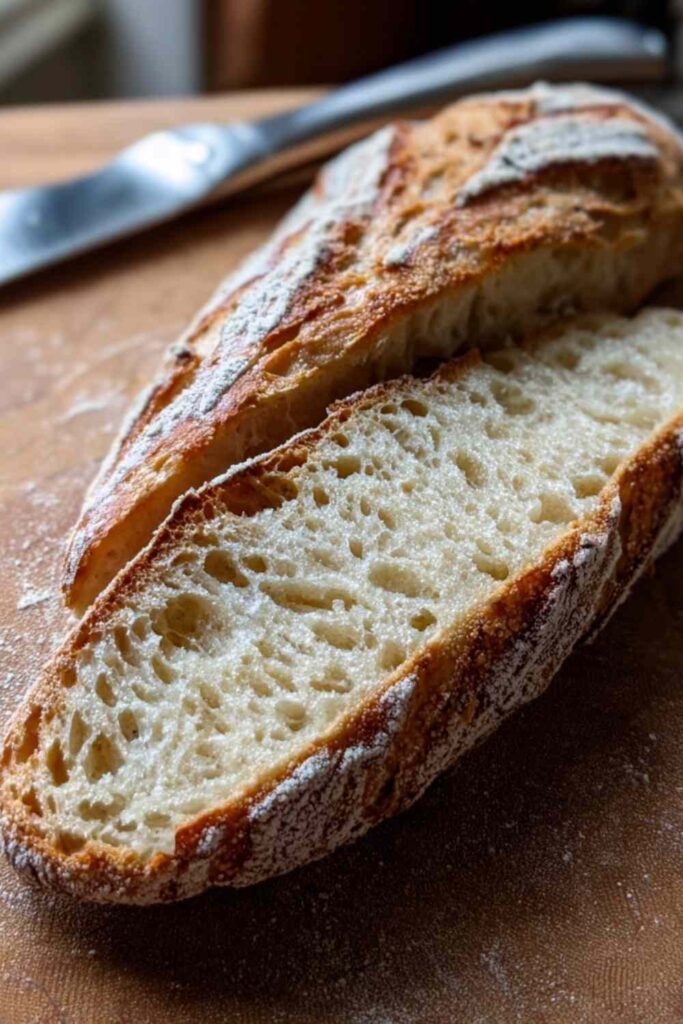
FAQs
How do I know when my baguettes are properly proofed?
I use the poke test – gently press the dough with your finger about half an inch deep, and it should spring back slowly but leave a slight indentation when ready to bake.
What’s the best way to score baguettes without deflating them?
Use a brand new, extremely sharp blade and make confident, swift cuts at a 30-degree angle – hesitation causes dragging and deflation, so practice the motion first.
Why do my baguettes come out flat instead of tall and oval?
This usually happens from insufficient gluten development during mixing, overproofing, or gentle handling during shaping – make sure to knead for the full 5 minutes and don’t let them proof too long.
Can I make these without a baking stone?
You can use an inverted sheet pan preheated in the oven, though the bottom crust won’t be quite as crispy – just make sure whatever surface you use is thoroughly preheated for at least an hour.
Sourdough Baguette Recipe – 6 Golden Loaves
Advanced-level sourdough baguettes with a caramelized crust and tender interior. Ideal for home ovens, crafted through a two-day fermentation process.
- Prep Time: 1 hour
- Cook Time: 45 minutes
- Total Time: 30 hours
- Yield: 6 demi-baguettes 1x
- Category: Bread
- Method: Baking
- Cuisine: French
- Diet: Vegetarian
Ingredients
- Levain:
- 2.6 oz (74g) white flour (11.5% protein)
- 2.6 oz (74g) water
- 1.3 oz (37g) ripe sourdough starter, 100% hydration
- Autolyse:
- 37.7 oz (1068g) white flour (11.5% protein)
- 23.6 oz (668g) water
- Main Dough:
- 2 oz (57g) water
- 0.7 oz (21g) fine sea salt
- 6.6 oz (186g) ripe levain
Instructions
- Day 1 – Prepare Levain (9:00 a.m.): Mix levain ingredients. Cover and ferment 5 hours at 74–76°F.
- Autolyse (1:00 p.m.): Mix flour and water until combined. Rest 1 hour covered.
- Mix (2:00 p.m.): Add salt and levain to autolyse dough. Knead 5 minutes using slap and fold until smooth. Transfer to fermentation container.
- Warm Bulk Fermentation (2:15–4:45 p.m.): Do 3 sets of stretch and folds every 30 minutes. Let rest.
- Cold Bulk Fermentation (4:45 p.m.–9:00 a.m. next day): Refrigerate covered overnight.
- Day 2 – Divide & Preshape (9:00 a.m.): Turn dough out. Divide into six 11.5 oz (325g) pieces. Preshape and rest 35 minutes uncovered.
- Shape (9:50 a.m.): Shape into 14-inch baguettes. Place seam-side up on floured couche with folds between each.
- Proof (10:15 a.m.–12:00 p.m.): Proof at room temp until dough passes poke test.
- Bake (12:00 p.m.): Preheat oven to 450°F with stone inside. Bake 3 at a time: steam oven, bake 20 min, remove steam, bake 20–25 min more. Cool on rack.
Notes
- Use white flour with 11.5% protein for ideal structure.
- Keep dough at 78°F for fermentation control.
- Score decisively with sharp blade to avoid tearing.
- Practice shaping frequently—baguettes need technique.
Nutrition
- Serving Size: 1 demi-baguette
- Calories: 270 kcal
- Sugar: 1g
- Sodium: 400mg
- Fat: 0.5g
- Saturated Fat: 0g
- Unsaturated Fat: 0.5g
- Trans Fat: 0g
- Carbohydrates: 56g
- Fiber: 2g
- Protein: 7g
- Cholesterol: 0mg





